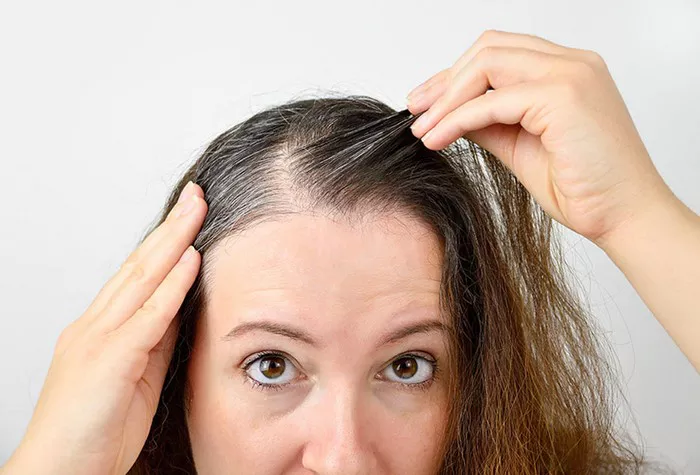Pregnancy brings about a myriad of changes in a woman’s body, and one of the common experiences many new mothers face is postpartum hair loss. Also known as postpartum alopecia, this temporary hair shedding occurs after childbirth and can be a cause of concern for many women. In this comprehensive guide, we will explore the causes of postpartum hair loss, its duration, and provide effective coping strategies to help new mothers navigate this phase with confidence.
Understanding Postpartum Hair Loss
Postpartum hair loss is a normal physiological response that occurs in many women after giving birth. During pregnancy, hormonal changes cause a decrease in the normal hair shedding cycle, resulting in thicker and more abundant hair. However, after childbirth, hormone levels normalize, and the hair follicles return to their normal growth and resting phases. This transition triggers the shedding of excess hair, leading to postpartum hair loss.
Causes of Postpartum Hair Loss
The primary cause of postpartum hair loss is hormonal fluctuations. During pregnancy, elevated levels of estrogen prolong the growth phase of the hair cycle, resulting in reduced hair shedding. However, after delivery, hormone levels decrease rapidly, causing the hair follicles to enter the resting phase. This sudden shift from the growth phase to the resting phase leads to increased hair shedding.
Another contributing factor is the psychological and physical stress associated with childbirth and the demands of caring for a newborn. Stress can disrupt the normal hair growth cycle, leading to excessive shedding.
Duration of Postpartum Hair Loss
Postpartum hair loss typically starts around three to four months after giving birth. The shedding usually peaks around four to six months postpartum and gradually subsides within six to twelve months. By the time the baby reaches their first birthday, most women notice a significant reduction in hair shedding, and hair growth returns to its normal cycle.
It’s important to note that the duration and intensity of postpartum hair loss can vary among women. Some may experience milder shedding that resolves more quickly, while others may have more pronounced shedding that lasts longer. However, it’s crucial to remember that postpartum hair loss is a temporary condition, and most women will regain their normal hair density within a year.
Coping with Postpartum Hair Loss
While postpartum hair loss is a normal and temporary phenomenon, it can be distressing for new mothers. Here are some effective strategies to cope with postpartum hair loss:
1. Maintain a Healthy Diet
Eating a balanced diet rich in vitamins and minerals can support hair health and growth. Focus on nutrient-dense foods such as fruits, vegetables, lean proteins, whole grains, and healthy fats. Include foods rich in biotin (eggs, nuts, and seeds), vitamin C (citrus fruits, berries, and leafy greens), and iron (red meat, legumes, and spinach) to promote hair growth.
2. Practice Gentle Hair Care
Be gentle with your hair during the postpartum period. Avoid excessive brushing or combing, and use a wide-toothed comb to detangle your hair. Minimize the use of heat-styling tools and harsh chemicals that can further damage the hair. Choose mild shampoos and conditioners that are gentle on the scalp and hair follicles.
3. Consider a New Hairstyle
Opting for a shorter hairstyle or a different cut can help minimize the appearance of hair loss. Shorter haircuts can create the illusion of more volume and make the hair loss less noticeable. Consulting with a hairstylist experienced in working with postpartum hair can provide valuable guidance on styles that suit your hair type and texture.
4. Avoid Pulling or Traction
Avoid hairstyles that put excessive tension on the hair, such as tight ponytails, braids, or buns. These styles can contribute to hair breakage and exacerbate postpartum hair loss. Opt for loose hairstyles that allow your hair to breathe and minimize stress on the hair follicles.
5. Embrace Hair Accessories
Hair accessories can be your best friends during the postpartum period. Headbands, scarves, hats, and hair clips can help conceal areas of thinning hair and add a stylish touch to your overall look. Experiment with different accessories to find ones that suit your personal style and complement your outfits.
6. Seek Emotional Support
Hair loss can have an emotional impact, especially during a time when new mothers are already adjusting to many changes. Reach out to your partner, family, or friends for support and understanding. Joining support groups or online communities specifically for postpartum women can provide a safe space to share experiences and receive emotional support from others going through similar challenges.
7. Be Patient and Positive
Remember that postpartum hair loss is temporary and part of the natural recovery process after giving birth. Be patient with yourself and your body as it adjusts to the changes. Focus on the joy of motherhood and the precious moments with your baby. Maintaining a positive mindset can help reduce stress and promote overall well-being.
8. Consult a Healthcare Professional
If you have concerns about the severity or duration of your postpartum hair loss, it is advisable to consult a healthcare professional or a dermatologist. They can assess your specific situation, rule out any underlying medical conditions, and provide personalized recommendations or treatment options to address your hair loss concerns.
Conclusion
Postpartum hair loss is a common and temporary condition that affects many women after childbirth. Understanding the causes and duration of postpartum hair loss can help new mothers navigate this phase with confidence and ease. By practicing healthy habits, seeking support, and maintaining a positive mindset, women can cope effectively with postpartum hair loss and focus on the joy and beauty of motherhood.
Remember, your hair will gradually regain its normal density and growth pattern within a year. In the meantime, embrace your natural beauty, explore different hairstyles, and celebrate the incredible journey of motherhood.


